Recycling Programs
"Please be loud."
What sounds like the exhortation in the sleeve notes of a Rolling Stones album is in fact the recommendation of writer, filmmaker, and self-described meta-archivist Rick Prelinger at the start of a screening of his film Lost Landscapes of Detroit. Introducing it at the Full Frame Documentary Film Festival in Durham, North Carolina, this spring, Prelinger primes a small but packed screening room for an experiment in "live cinema" in which viewers are encouraged to speak—or even shout—their responses to the collection of amateur and industrial film that documents fragments of the city's history between 1917 and 1970.
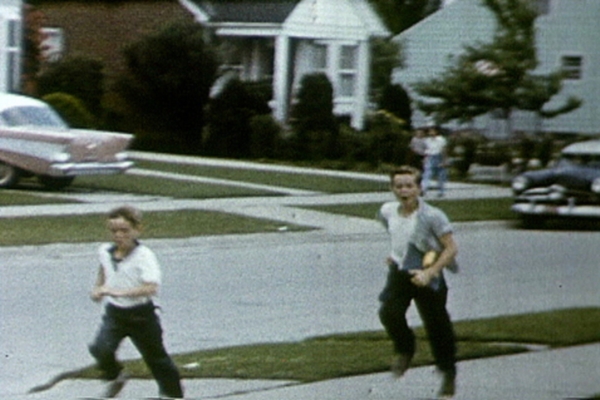
Lost Landscapes of Detroit
In this exercise in audience participation, viewers can yell out stories, anecdotes, factoids, and questions, creating an ad hoc, collective psychogeographical mapping of some of Detroit's forgotten places. And although nearly 700 miles separate Durham and Detroit, there are enough sometime or inveterate Michiganders in the audience to identify long-departed local sites like Vernors Ginger Ale plant, Hudson's department store, and the Madison Theater. At one moment, Otto Preminger and Lee Remick, promoting their new film Anatomy of a Murder in 1959, wave from the back of a convertible with the likes of Governor Mennen Williams and Mayor Louis Miriani in a motorcade at the city's annual Freedom Festival; later, an African-American congregation assembles to celebrate the opening of a church not far from the "Black Bottom" neighborhood, a black community "redeveloped" in the early 1960s to make way for the Chrysler Freeway.
The second in a series of continually revised films that began with 2006's Lost Landscapes of San Francisco, Prelinger's film was one of 10 works he assembled in "One Foot in the Archives," a program of archival documentaries at this year's Full Frame that included an international selection of nonfiction works, new and old, that draw upon and contend with pre-existing moving image material from archives. Alongside March of Time and News of the Day newsreels from the 1930s and '40s, as well as Lost Landscapes of Detroit and a presentation the curator called "Raw Material, Indigestible?" these films provoked a set of questions about the writing and rewriting of history through documentary cinema.
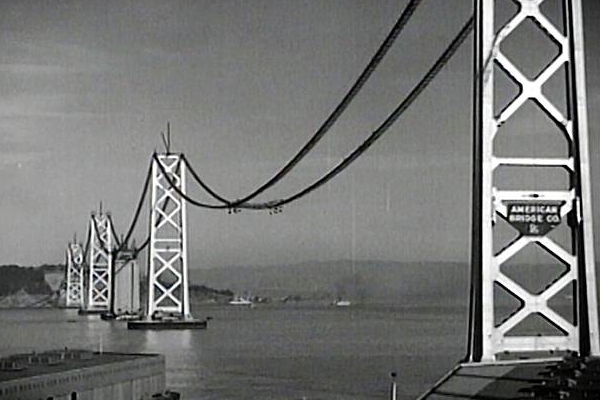
Lost Landscapes of San Francisco
Now that archives, digital tools, and online resources, legal and otherwise, have made vast and increasing amounts of moving image material available and manipulable to anyone with a computer and Internet access, the ethical and aesthetic issues of such image-recycling are more pressing than ever.
***
While much of the critical discussion of documentary aesthetics has focused on issues of veracity, ethics, representation, and performance—issues derived mainly from the study of cinema verité—an overwhelming number of nonfiction moving image works are composed, in whole or in part, from pre-existing material rather than more direct, filmmaker-subject encounters. From the vast array of theatrical and broadcast biopics about artists, athletes, and politicians, to the more elaborate studies of archival material produced by Adam Curtis and Harun Farocki, documentary films have long relied on the archive as a source of visible evidence.
Avant-garde filmmaker and historian Jay Leyda sought to initiate the study of such archival-based works with his 1964 book Films Beget Films, though he was hard-pressed to find an appropriate label for them. Compilation film, archive film, library film, stock-shot film, documentary archive film, chronicle montage film, film de montage: none quite fit the complexity and specificity of the form as he saw it. "The proper term would have to indicate that the work begins on the cutting table [and that] that the film used originated at some time in the past," Leyda suggested. "The term should also indicate that it is a film of ideas, for most of the films made in this form are not content to be mere records or documents." For Leyda, the best of these works didn't just cite film clips from archives as simple primary sources, but questioned and commented on them, too, serving as a kind of meta-documentary. The earliest examples of these "compilation films"—like Esfir Shub's The Fall of the Romanov Dynasty (1927) and Frank Capra's Prelude to War (1942)—appropriate newsreels and propaganda for their own uses, calling attention to their subliminal messages and peripheral insights. What most fascinated Leyda was "the mysterious process" by which "the squirming, seemingly formless larvae of Newsreels ... would suddenly spring into public notice (even demanding proper reviews) on the gorgeous wings of a respectable term, Documentary."
With the advent of digital archives, online databases, and searchable metadata, the manipulation of archival material in all kinds of media is ubiquitous, as evidenced by the variety of such recent works as Errol Morris's Tabloid and James Marsh's Project Nim, and even Jean-Luc Godard's Film socialisme and a number of Kevin Jerome Everson's films (like Something Else [2007], According to [2007], Second and Lee [2008], and Telethon [2009], now on view at the Whitney Museum of American Art). Patricia Aufderheide and Peter Jaszi's new book Reclaiming Fair Use: How to Put Balance Back in Copyright (University of Chicago Press) figures the contentious issue of copyright as "an unwinnable and unnecessary battle" between "mass-media corporations fighting for control of what they understand to be their enclosed garden" on one side and those "who make new cultural works—often artists, remixers, appropriators, self-styled pirates" on the other. Aufderheide and Jaszi note that the real losers in this battle are those caught in the middle—educators, bloggers, and common citizens who simply want to make use of those materials available to them. Explaining his new film's title and its closing image of a fuzzy FBI warning logo, Godard has stated, "The socialism of the film is the undermining of the idea of property, beginning with that of artworks."
Rick Prelinger is at the center of this debate, having made thousands of films from his enormous collection available online for free at the Internet Archive and continuing to furnish archival footage to many documentaries that play at Full Frame, online, and in theaters and festivals around the world. For him, the future of documentary—and, indeed, all kinds of media—will involve a "scaled-up engagement with the archives," thanks to the proliferation of such tools and resources in the digital age. But as his program at Full Frame, along with his work as a media-maker and archivist, show, the problems that such practice poses are far from resolved.
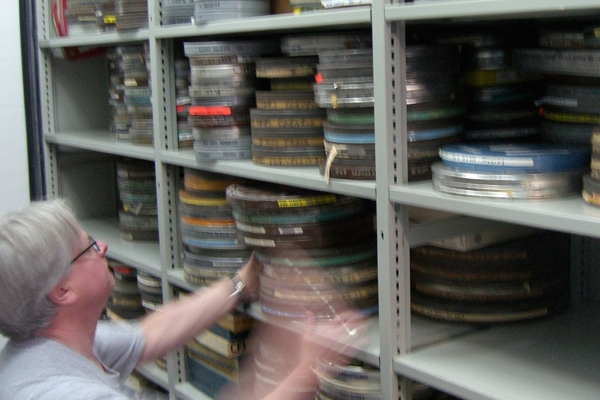
Rick Prelinger
***
Though primarily concerned with Leyda's "squirming, seemingly formless larvae," Rick Prelinger has long been fascinated (and occasionally troubled) by the process by which this raw material is reworked into documentary cinema. His career as an archivist largely began because of it: as a writer on the 1989 film Heavy Petting, a sly mashup of sex-ed films, Prelinger's friend Pierce Rafferty hired Prelinger as a researcher. In 1982, Rafferty, along with Jayne Loader and brother Kevin Rafferty, had made The Atomic Cafe, a similarly tongue-in-cheek hodgepodge of newsreels, ads, and military-training films about the nuclear threat, which benefited (as had Bruce Conner's 1976 film Crossroads) from the amendments to the Freedom of Information Act that President Gerald Ford had enacted in 1974, affording new access to government records that directly concern citizens. Soon, Prelinger became obsessed, amassing an archive of industrial and sponsored films that, at its largest, totaled some 60,000 films, 60 percent of which were in the public domain. (Many of the works Prelinger started collecting as a result of working on Heavy Petting later screened as part of the series "Mental Hygiene: Social Guidance Films 1945-'70," curated by Prelinger and Ken Smith at the Museum of the Moving Image in 2000.)
In 1995, Prelinger produced a 12-volume CD-ROM for the Voyager Company (the original publisher of the Criterion Collection) called Our Secret Century, a collection of some 100 films with contextual material from the 1930s to the '50s that tries to unpack and expose the collusion between media, government, and big business in selling the myth of an ideal American society. Designed, as he later stated, "to be a desktop archive that anyone could use and repurpose as they pleased," the CD-ROM series proved an important development in Prelinger's ideas about the ways in which technology could make archival material more available—and even usable—to more people. "I realized that my project was really the practice of vernacular history in the public sphere, and began to think in terms of historical intervention."1
In 2000, Prelinger began making some of these films available online—free of charge—at Brewster Kahle's Internet Archive, which now houses more than 2000 moving image works from Prelinger's collection. "You are warmly encouraged to download, use and reproduce these films in whole or in part, in any medium or market throughout the world," the Prelinger Archive's copyright notice declares. "You are also warmly encouraged to share, exchange, redistribute, transfer and copy these films, and especially encouraged to do so for free. Any derivative works that you produce using these films are yours to perform, publish, reproduce, sell, or distribute in any way you wish without any limitations." (There's also a brick-and-mortar version: San Francisco's Prelinger Library, opened by Rick and his wife and partner Megan in 2004, a similarly "appropriation-friendly" storefront that houses about 40,000 books, periodicals, and documents for use by media-makers, armchair historians, and passersby alike.) To Prelinger's surprise, the increased availability of his collection made his team "implicit collaborators with hundreds of thousands of people around the world who downloaded our films for use in their own media productions."2 And strangely, as more of its material became available online for free, the Prelinger Archive started to turn more of a profit for licensing, thanks to a two-tier, "free and fee" system, which offers nonprofit users near-DVD-quality moving image material under a Creative Common license, and charges commercial projects or organizations for higher-quality images and written licenses.
By his own account, though, Prelinger's interest in industrial and educational films peaked with the production of Our Secret Century; now, his emphasis has shifted to home movies. Prelinger's renewed interest in this "bastard genre" coincides with what he calls a "gentrifying moment" for home movies: since 2002, the Center for Home Movies (CMH) has coordinated celebrations of Home Movie Day every October 15, and in 2008 the Library of Congress added the first home movie to the National Film Registry, Robbins Barstow's utterly charming 1956 film Disneyland Dream. For Prelinger, home movies are "the ultimate floating documents," opening an enormous and largely untapped vein of information about the past, a history parallel to that offered by more official sources like newsreels.
"They are the great exception to what we usually think of as film," he explained in a presentation at San Francisco's Long Now Foundation in 2009. "They typically show scenes of everyday life; they're made by unknown authors; and above all, they're personal expression, not commercial or corporate expression. Each reel is unique [and] most reels were never duplicated; only one original exists. These are more than evidence; these are also unique artifacts." Speaking with CMH co-founder Skip Elsheimer at Full Frame, Prelinger noted his desire to "elevate amateur media and home movies to the same level that documentaries enjoy right now. I'd like us to come to film festivals and watch unedited material and look at it as work with integrity and narrative and intention, rather than trying to unpack what Howard Hawks did in this or that feature, or to understand narrative on a Hollywood level. I'd like to understand these areas that are still pretty opaque."
If this largely undiscovered territory presents a new opportunity for media scholars and makers, it also poses a challenge for archivists and preservationists, who must contend with the massive amount of media yet to be collected, preserved, and catalogued. "The world is full of other people's home movies," Prelinger notes—"billions and billions of feet" of film, he ballparks—and while many specialized organizations and individual collectors have supplemented the work of more established archival institutions, the sheer volume remains insurmountable. But even this problem can drive creative practice and scholarly discourse. "Loss can be formative," he notes in a blog entry at SF MOMA's website. "Much artistic and historical practice today has an archaeological inflection; it's devoted to chasing forgotten discourses, near-mythical communities, and liminal situations."
But he also notes, "archaeology is certainly easier when the evidence hasn't been thrown away."
***
Fond of invoking Craig Baldwin's insight that archival and found-footage filmmaking represents a new type of folk art, Prelinger repeatedly articulates his belief in the importance of the relationship between archivists, media-makers, and the general public in reconstructing history. But what is crucial for Prelinger is that this process remains open, continuous: as he explained to me in an interview this past May, "the archive is not an end-point, but a beginning." Prelinger laments that documentary films too often default to a staid form of construction that seeks closure over complexity, processing archival and other materials through "the storytelling Cuisinart."
"Of course, there's nothing wrong with storytelling," he explains in his Full Frame program notes, "and not all stories are bad. What's wrong is the assumption, which has become not only pervasive but something of a straitjacket, that documentaries need characters, that the narrative arc must reign supreme, and that we're obliged to show people wrestling with and resolving problems." While contemporary documentary is often about "giving people a handle on complex phenomena," its persistent tics and clichés—"overbearing narration, emotionally invasive music, and overly personalized visions of history"—tend to quash the miniature narratives and raw, contingent details already deeply embedded in archival images, replacing such historical nuance for simple narratives.
Or worse: nostalgia. As an archivist, Prelinger is acutely aware of the pitfalls of preserving the past in any chopped, mixed, or puréed forms, as evidenced by a succession of epigrams that he posted to his Twitter feed this past May:
Nostalgia tends to ask questions for which we already know answers; historical intervention asks questions with no easy answers.
Nostalgic feelings have been appropriated by commercial & authoritarian forces seeking to deprive us of active agency in the present.
I would rather reclaim history from nostalgia than derive nostalgia from history.
In his program of films at Full Frame, Prelinger offered an array of aesthetic possibilities for reclaiming history from narrative oversimplification and nostalgic reductionism through an engagement with the archives. Rather than include better-known archival documentaries (like those of, say, Emile de Antonio), the series highlighted two films from the 1970s that address the history of the Great Depression through its images—in startlingly contrasting ways. America Lost and Found (1979), directed by Lance Bird and Tom Johnson and narrated by a very matter-of-fact Pat Hingle, relies on Fox Movietone, Hearst Metrotone, Paramount, Pathé, and Universal newsreel footage to document the 1929 stock market crash and its aftermath in an essayistic and meticulously researched fashion. For Prelinger, the film is "a kind of tutorial on how to think about these ambiguous archival images," juxtaposing incongruous images of wealth and poverty, while the voiceover calmly intones a word of caution that might almost come from Prelinger himself: "We make out of the records the past we need. There is, in the end, only the present."
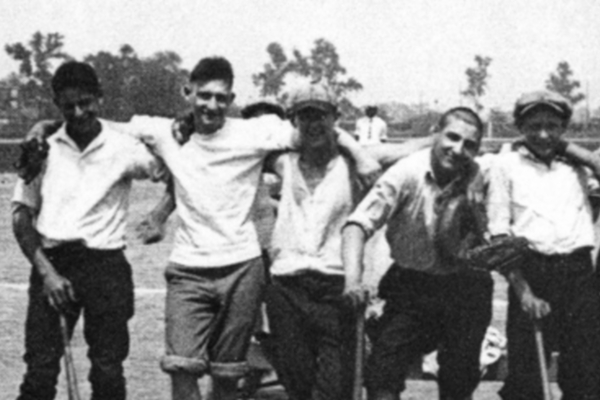
America Lost and Found
Comparatively manic, Franco-Australian filmmaker Philippe Mora's Brother, Can You Spare a Dime? (1976) mashes up similar newsreel footage with incongruously glittery images from Hollywood films. Busby Berkeley and Shirley Temple films are matched with images of breadlines and dust bowl refugees, and a montage aligns the vacillating public opinion about FDR to the shifting star persona of Jimmy Cagney. An often shocking contrast to America Lost and Found, Brother, Can You Spare a Dime? concludes with an anachronistically psychedelic image of apocalypse: a contemporary animation of the one-dollar bill's Eye of Horus exploding, which Mora filters through the analog fuzz and tertiary colors of a video synthesizer. Here are two of Prelinger's most polarized possibilities for documentary historiography: one investigates and interrogates the contradictory and ambiguous documents of the past; the other submits them to blithe, relentless reconfiguration with little regard for chronology or narrative.
Further selections prompt questions not only about the creative use of archival material, but also the role and meaning of the archives themselves. A trio of films from Eastern Europe and Russia all draw from and reinterpret the official archives of formerly socialist states, suggesting a link with Esfir Shub's The Fall of the Romanov Dynasty, which repurposed footage shot by the Czar's own cameramen in order to expose the decadence of the Bolsheviks. Strictly Propaganda (known in German as Kinder, Kader, Kommandeure), Wolfgang Kissel and C. Cay Wesnigk's droll 1991 collection of East German propaganda and training films, offers a sometimes eerie, often hilarious, and curiously fond look back at the media-image of the DDR during the Cold War. What's striking is the similarities in tone and style with contemporary propaganda films from the West: smart, dutiful children help track down pernicious Western spies; refugees flee the crumbling consumer culture across the border and are welcomed with open arms by their East German brothers; and, in a curious mirror-image of Peter Watkins's The War Game, state officials advise on the best ways that citizens can clean up and help others after a nuclear attack. Prelinger notes that Kissel and Wesnigk's reconsideration of this material, coming only a year after German reunification, "draws a fuzzy line between archives-as-ironic-distance and archives-as-therapy."
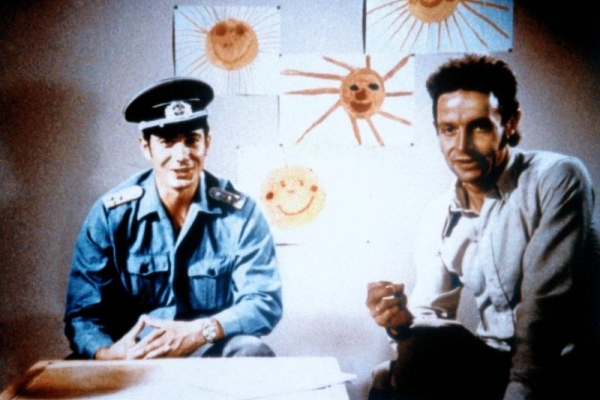
Strictly Propaganda
Sergei Loznitsa's 2005 film Blockade serves a similar function, albeit with much more somber undertones. Culling from hours of little-seen footage from Soviet archives, Loznitsa recounts the siege of Leningrad, which lasted 900 days from 1941 to 1944 and claimed the lives of some 800,000 residents. Blockade's reconstruction raises questions about the role of archives and the presentation of archival footage. As all of the footage was silent, Loznitsa adds a meticulously constructed soundtrack, lending these mute images of everyday struggle and desperation new resonance and detail. Loznitsa's next film, Revue, is closer in tone and subject matter to Strictly Propaganda, but Blockade memorializes the unwitting and unheralded people often elided in grand historical narratives.
Combining Kissel and Wesnigk's archival intervention and Loznitsa's aural reconstruction, Andrei Ujica further challenges the purpose and meaning of the archive with his masterful Autobiography of Nicolae Ceausescu (2010), an apocryphal pseudo-memoir of the Romanian dictator's nearly 25-year rule (and fatal downfall), told through state-sanctioned footage and home movies. Alternating between deadpan satire and a sentiment that approaches pity, Ujica allows the diminutive, schlubby Ceausescu to come through as a kind of comical, accidental despot, a pawn in the vast chess match of state socialism who nonetheless enjoys awkward state visits with Mao, Kim Il-sung, Nixon, and Gorbachev, water-skis and plays volleyball on vacation (he cheats), and initiates enormous and costly landmarks to himself in the midst of an economic recession. After all this globetrotting glamour and the pomp and circumstance of diplomacy, one might almost feel sorry when the regime is overthrown and the "Genius of the Carpathians" and his wife Elena are cornered for interrogation (later to be executed by a firing squad). But throughout the film, Ujica's carefully textured soundtrack, which layers Ceausescu's addresses to the nation with a newly created foley of ambient sounds and background noise (along with an uncanny use of Ligeti's Poème Symphonique for 100 metronomes), suggests the quiet murmur of the crowd that the leader and his entourage of cameramen so consistently ignored.
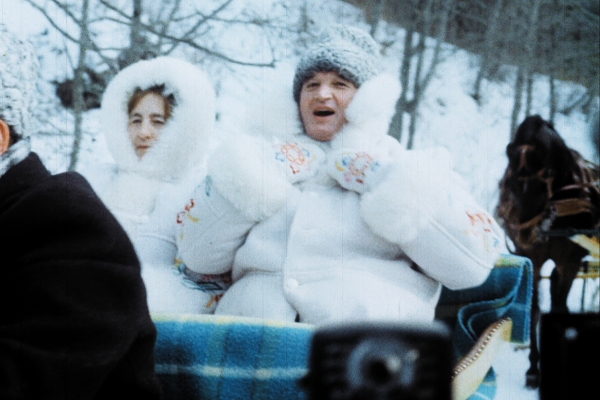
The Autobiography of Nicolae Ceausescu
***
Since 2004, Prelinger been trying out his theories of the archive with a number of works that explore his own collection, and many questions about the meaning and uses of archival images convene in his own Lost Landscapes of Detroit. Like Leyda, Prelinger isn't wholly sure what to call his works—"I hate to call them ‘film-films'," he says—opting for the term "slow collages" instead. His first of these, Panorama Ephemera, which took "20 years and eight months" to make (the eight months of which was the period of active editing), explores a format of compilation that Prelinger has largely maintained since: editing together relatively long sequences in order to retain the structure and temporality of the original material. A collection of sponsored films that deal with everything from pig butchery to auto manufacturing, the fight against big business to the behavior of coyotes, Panorama Ephemera often seems like Prelinger's own mixtape of mid-century America's unconscious fears and motivations, with cautionary instruction about proper fire, gun, and car safety and the need for insurance. Unlike his predecessors, though, Prelinger aims not to distill commonalities or form an easy, comic tableaux of the zeitgeists of yesteryear, but instead to revel in the cacophony of the ideas through juxtaposition—much as Mora's film does, but less frenetically.
With the Lost Landscapes series, Prelinger's interest lies more in topography than chronology, cutting across history to compare locations at various moments in a city's history. Through audience participation, Prelinger tries to create a "4D model" that mimics the kind of user annotation one finds on the Internet—call it a live crowd-sourcing of metadata—identifying locations and time periods, and sharing anecdotes and forgotten histories. In Prelinger's view, this is like a cinematic geotagging, where the audience is able to "attach spatial coordinates to an image; not just where it was shot, but what it sees." This reconception of both cinematic space and form suggests how Prelinger's work with online archives has informed his thinking about fresh correspondences between old and new media. "Today we can document daily life with almost infinite granularity," he explained in May. "In fact, we're approaching the Borgesian, one-to-one correspondence between the world and the map. But documentation of the past is of a different class. It's finite, it's often precious—we wish we had more." In this sense, the group experiments of the Lost Landscapes series offer the chance to fill in some of these historical gaps, and to reroute the usual historical narratives. Here again, Prelinger is equivocal about the nomenclature: "Maybe Lost Landscapes is a misnomer: we're not just getting together to watch old footage; we're a focus group on what the future could be."
He began this experiment in San Francisco, where he lives, and now screenings of the city's own Lost Landscapes have become an annual event. His interest in Detroit grew out of his frequent trips there to collect films made by one of the city's many production companies, like the now-defunct Jam Handy Organization. Prelinger explains: "They used to say—and it might be apocryphal—that more film was exposed in Detroit than in New York and Hollywood combined. Detroit was within 400 miles of most of the industrial production and most of the population of America."
And yet, combined with this wealth of archival material, Detroit's more recent history makes it a ripe subject for Prelinger's project of psychogeographic reconstruction. According to the 2010 census, Detroit has lost about a quarter of its population in the past decade. There, the historical narratives of economic decline, post-industrial decay, and abandoned neighborhoods are difficult to shake, but they seem less like foregone conclusions in light of Prelinger's images of crowded mid-century shopping streets or jolly home movies of family trips to Belle Isle Park. Rather than the grand historical trajectories that most documentaries sketch out, these micro-narratives are the ones Prelinger feels are worth revisiting as a way of rereading the past and reimagining the future. And this process begins with greater access to and interactivity with the archive. For Prelinger, as he explained at Full Frame. "this marks the fulfillment of a kind of civic right that too often goes unrecognized: that every generation and group is entitled to reintepret history from wherever it stands and towards its own ends, and that everyone has the right to excavate, edit, and surprise."
1. Anna Ramos, Vicki Bennett, & Jon Leidecker. "Memorabilia: Collecting Sounds with Rick Prelinger." Ràdio Web MACBA, April 2011. http://rwm.macba.cat/uploads/twitter/memorabilia_rickprelinger_eng.pdf.
2. Steven Heller. "For Your Appropriation: An Interview with Rick Prelinger." AIGA, March 2010. http://www.aiga.org/for-your-appropriation-an-interview-with-rick-prelinger. ![]()
LATEST ARTICLES
-20140814-173707-thumb3.jpg)
Fighting Words
by Imogen Sara Smith
posted August 12, 2014

Fighting Words, Part 2
by Imogen Sara Smith
posted August 20, 2014

On the Margins: The Fil…
by Andrew Chan
posted August 12, 2014

Robin Williams: A Sense…
by David Schwartz
posted August 12, 2014
 Recycling Programs
Recycling Programs
FURTHER RESEARCH
Blog posts by Rick Prelinger at SFMOMA.orgCenter for Social Media guide to fair use in documentary film
THE AUTHOR
Leo Goldsmith co-edits the film section of The Brooklyn Rail and is a PhD candidate in the Department of Cinema Studies at New York University. He contributes regularly to Not Coming to a Theater Near You and Reverse Shot.
More articles by Leo GoldsmithAuthor's Website: Not Coming to a Theater Near You

